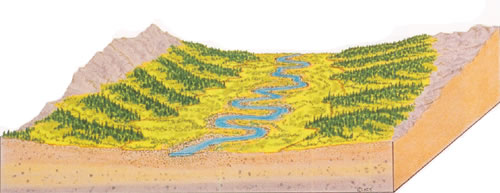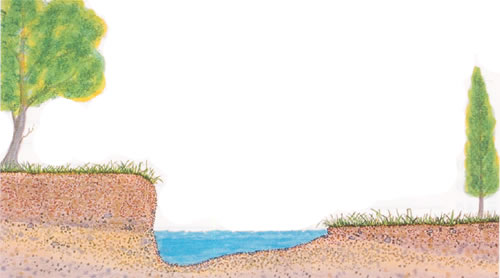
| glossary | menu | Normal | lg | hc | 4.) Geomorphologic Classification Systems > Meandering Streams |
| < Previous | 1 | 2 | 3 | 4 | 5 | 6 | 7 | 8 | 9 | 10 | 11 | 12 | 13 | 14 | 15 | 16 | 17 | 18 | 19 | 20 | 21 | 22 | 23 | 24 | 25 | 26 | 27 | 28 | 29 | 30 | 31 | 32 | 33 | 34 | 35 | 36 | 37 | Next > |
Meandering Streams


Meandering channels are the second of a simple three part classification by early geomorphologists, as reported by Leopold, Wolman and Miller (1957) and Schumm (1977).
These images show the oblique view and cross sectional view of a Meandering channel with a wide Meander belt width. The cross sectional dimension view illustrates the cut-away bank with a deep pool and the opposite point bar slope grading into the flood plain. Often Streams of this nature are in the more gentle sloping and wide Valleys, where the Stream can laterally migrate across the Valley, eroding Floodplain on the cut-bank side, and building Floodplain on the point bar side. The Meanders help the Stream to dissipate hydraulic potential energy through scour and turbulent eddies. Meandering channels are considered intermediately stable with semi-cohesive bank material, moderate bedload and suspended sediment.
Image courtesy of Rosgen
| < Previous | 1 | 2 | 3 | 4 | 5 | 6 | 7 | 8 | 9 | 10 | 11 | 12 | 13 | 14 | 15 | 16 | 17 | 18 | 19 | 20 | 21 | 22 | 23 | 24 | 25 | 26 | 27 | 28 | 29 | 30 | 31 | 32 | 33 | 34 | 35 | 36 | 37 | Next > |